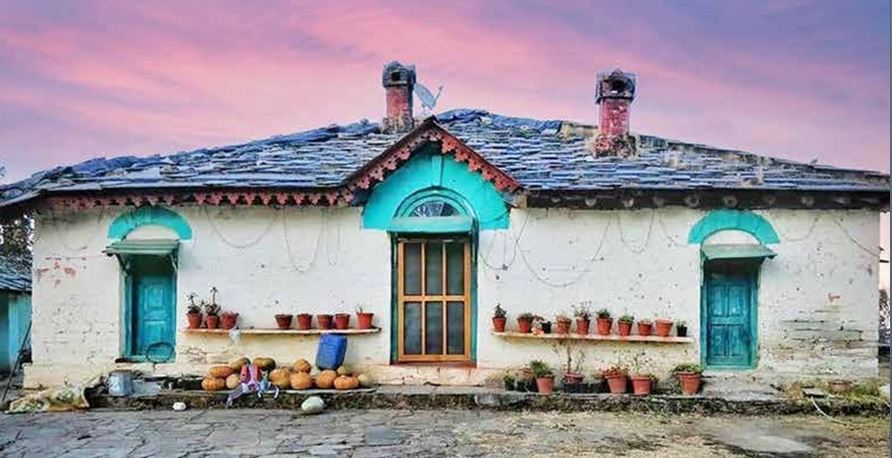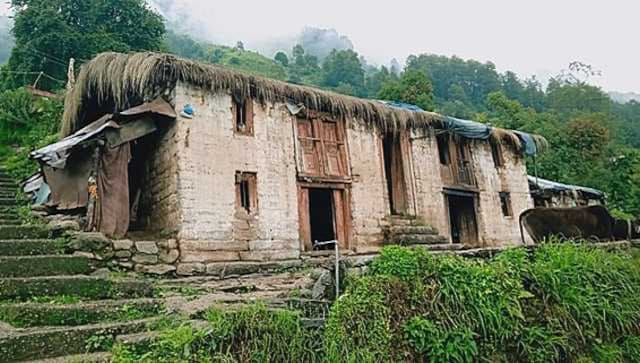House of Cards HIMALAYAS

By C K Nayak
Isolated but compact pagoda style houses with the Himalayas in the background are subject of any colourful picture postcard and tourists delight. Many settlements in the region have maintained these unbroken traditions in their cultural practices and their built form. But as the settlements become more connected with other parts of the country with expansion of economy, vernacular architecture traditions of the area are undergoing sea changes.
People living in the region from ages have built their houses from locally available eco-friendly material suitable to the topography of the region which is highly seismic prone being in Zone IV. But later on with expansion of population and business mainly tourism, spiritualism and several other factors houses are built with bricks and concrete not known in the region earlier. Meanwhile, the entire region has undergone serious climate changes with even heat waves and summer rains unheard of in the salubrious climate earlier. A price has been paid for the so-called modern, quick and cheap habitats to accommodate more and more people, mainly to suit with the expanding economy. Houses have been washed away and buried under the massive landslides. Earthquakes have taken their own toll since these houses are not built quake proof unlike the traditional ones.
But some innovative people of the region are now trying to turn the clock back. One merchant navy professional, Guru Dutt Goswami takes time off from work to stay in his ancestral home in Palampur in Himachal Pradesh. The mud, stone and wood structures, built decades back along Himalayan slopes, stay warm in winter and cool in summer. A retired major in the army Major Gorki Chandola and his famil returned to their ancestral village, Rawatgoan, in Uttarakhand after living for decades in cities. They decided to restore the century- old ancestral home where he had lived as a child instead of building a new concrete one like others.
Interestingly, seeing the renovated houses and its usual comfort many others in both the Himalayan states followed suit. Some built news houses in old style but others renovated their ancestral house and lived happily away from the busy city life and munching the past.

But such people faced many challenges in the beginning. First was scarcity of raw material even if it was locally available. Earlier there were no restrictions on cutting trees for building houses. But no more. There are restrictions though to a lesser extent on digging earth and stone. Even if the material was available elsewhere there was a problem of transportation since many villages have no proper road. There is also a lack of skilled stonemasons and woodworkers expert in old style house building. Over a time the unique art has been forgotten. Traditionally, houses in the region used urad dal, jiggery as a natural binding agent, which helps maintain the temperature during both summer and winter; the interiors would be decorated with wall paintings using traditional dyes. They had to train the masons to use traditional techniques. After restoring their own home, which they now use as a home stay, they also restored several old houses in the villages that were on the verge of collapse since there was no one to take care. Many others in the area, some of them even living in cities, have come back or at least built or rebuilt their houses for the future.
The silver lining is that while brick and concrete homes have become the norm in recent decades, the centuries-old tradition of making houses with mud and other local material is undergoing a resurgence in the Himalayan region. Some people have also made a judicious mixture of both ancient and modern. Like the main living room, bed rooms remain old style with stone, mud and wood but bathroom and kitchen have been cemented with floors tiled to suit modern living. Similarly large glasses have been used for windows and doors to allow more sunlight. Environmentalists have hailed the trend, saying that reviving old building traditions is one of the many answers to addressing modern day challenges such as climate change.
Besides individuals, some institutions have also stepped in to revive the traditional housing pattern. The Sambhaavnaa Institute of Public Policy and Politics, a non-profit organization that promotes sustainability, is setting an example – their own sprawling campus in Palampur is a mud structure. The small hill town is located in the midst of tea estates. “Reviving vernacular architecture is important,” says Mohammad Chappalwala, programs coordinator at the institute. “The idea is to build with local natural material and that is the direction we should be taking.” Made with mud dug out of the site where the building stands, stones, slate and bamboo from the hillsides, he says these houses reduce the carbon footprint – modern-day building materials such as steel and cement are created through carbon-intensive industrial processes and also must be transported across hundreds of miles burning depleting fossil fuels.
There are many other advantages – the lighter, lower structures are more earthquake resistant compared to concrete buildings being built in recent decades. “That has been proven by the houses which were left standing after the major earthquakes in the Himalayan region,” says Chappalwala. Architects say countries like India need to rethink emulating standardized international styles of concrete houses and glass and chrome skyscrapers and take a closer look at incorporating old traditions that evolved in the pre-electricity era. A growing number are reviving them in other parts of the country — they vary according to the region. “These were simple, common- sense strategies that were especially important in India, where you need to keep the heat out, contrary to colder places where they need to keep warmth within,” says Yatin Pandya, an architect who promotes sustainable architecture.
India is increasingly suffering from intense heat waves – the problem is compounded by glitzy glass and concrete buildings that trap heat. However, wider acceptance of traditional architectures remains a challenge — most residents in Himachal Pradesh, Uttarakhand and other Himalayan states still opt to build concrete homes that have become associated with development and status.
But some erstwhile city dwellers find that staying in a mud structure deepens their connection with the earth. It is very cooling, it is soothing to mind and body.
Source: Himalayan News Chronicle















टिप्पणीहरू